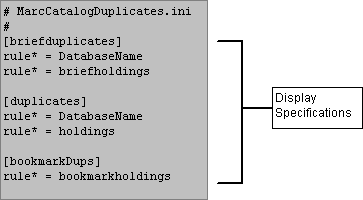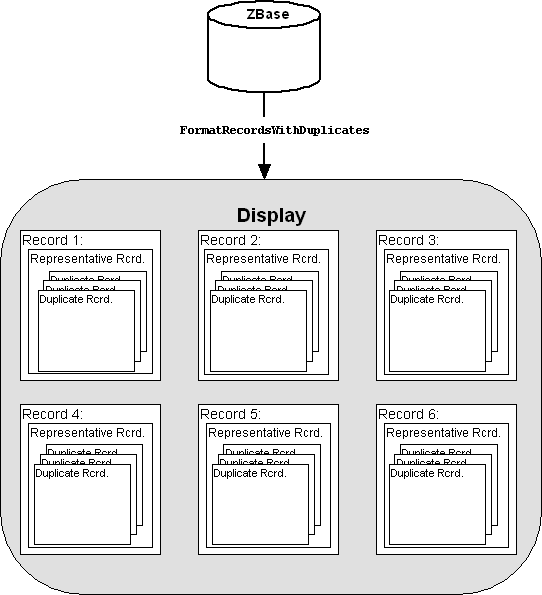Configuring Z39.50 Duplicate Detection Service
Successful implementation of Z39.50 Duplicate Detection Service in the WebZ interface is dependent upon the configuration of combined result set functionality. Only after result sets are combined can they be de-duplicated, sorted, and grouped according to a duplicate key that you define when you configure the service in the ini files for the databases that use it.
To configure your interface to use Z39.50 Duplicate Detection Service, you need to perform two general tasks:
- Define the duplicate detection specification.
- Include the duplicate formats in the individual database configuration files.
1.
Defining the Duplicate Detection Specification
Using your text editor, you can configure the Z39.50 Duplicate Detection Service for a single database or a group of databases by defining a duplicate detection specification in the corresponding database ini file or group ini file. A duplicate detection specification contains the following parameters and their values:
- Name of the duplicate detection key
- Maximum number of records in a result set that can be de-duplicated
- Number of duplicate records that are maintained under a representative record
- Sort criterion for ordering the duplicate records
- Indication of whether duplicate detection should occur automatically for results less than or equal to the value for MaxDedupRecords
For example, the following is the duplicate detection specification from the OBI, version 1:
| [dedup] key*=StandardNumberKey MaxDedupRecords = 500 MaxDedupRecordsToRetain = 100% SortCriterion = DbnameOrder preferredDatabaseNames = DRA endeavor III GEAC_Advance Horizon AutomaticDedupOnEverySearch = true |
| Note: |
This example duplicate detection specification is for a group of databases defined in the OPACGroup.ini file for the Virtual Catalog topic area in the OBI, version 1. You can, however, configure this service for an individual database by defining a duplicate detection specification in the appropriate database ini file. |
For complete steps on defining a new group database configuration file, see Creating a Database Configuration File.
Duplicate Detection Specification
Parameters
Some parameters are required for the duplicate detection specification and others are optional. The following is a breakdown of all the available parameters that you can use to create a duplicate detection specification.
Parameters of a Duplicate Detection Key Specification
The parameters used to define a de-duplication key specification are identical to those used to define a sort key.
|
Parameter |
Description |
|||
| name |
Name of the sort key as it will appear in the WebZ interface. |
|||
| use | This is an integer that identifies the index that is to be used to perform the sort. | |||
| parm<n> |
Complete BER tag path of the data field on which to sort. Multiple paths are specified as parm1, parm2, etc. Examples:
|
|||
| class |
This is the class that pulls data from the records on which de-duplication is performed.
|
|||
For more information
about sort key definitions
and their parameters, see Database Configuration
Files.
2. Include the Duplicate Formats in the Database Configuration File(s)
In order to view duplicates, you need to declare values for three parameters under the [Formats] section in each of the database configuration files for the current group.
- duplicates
- briefduplicates
- bookmarkDups
For example, the OBI, version 1 is able to display duplicate record information for the Virtual Catalog databases because the following formats are defined under the [Formats] section in each of the configuration files for the databases comprising the topic area:
![[Formats] variables for de-duplication](images/saimg_52-03-00r-1.gif)
Content of MarcCatalogDuplicates.ini
Notice that each of the above formats references the formatting configuration file, MarcCatalogDuplicates.ini, which contains the display and rule specifications that determine how duplicate records are to be displayed in the OBI, version 1.


Composite Records
The gadget, FormatRecordsWithDuplicates, ultimately is responsible for formatting duplicate records by retrieving representative records and their duplicates from ZBase to create composite records for display in the interface.
The following illustration depicts this process:

For more information about defining display specifications, rules specifications, and formatting configuration files, see WebZ Rules-Based Formatting.
| Note: | Duplicate detection service depends on the activiation of SupportsMultiDbQuery and SupportsMergeRead in the ZBase.ini file. Failure to set these two parameters to "true" inactivates duplicate detection. |
See Also